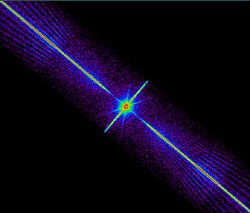May 07, 2001
CXC PR: 01-06
Using four NASA space observatories, astronomers have shown that a flaring black hole source has an accretion disk that stops much farther out than some theories predict. This provides a better understanding of how energy is released when matter spirals into a black hole.
On April 18, 2000, the Hubble Space Telescope and the Extreme Ultraviolet Explorer observed ultraviolet radiation from the object known as XTE J1118+480, a black hole roughly seven times the mass of the Sun, locked in a close binary orbit with a Sun-like star. Simultaneously, the Rossi X-ray Timing Explorer observed high-energy X-rays from matter plunging toward the black hole, while the Chandra X-ray Observatory focused on the critical energy band between the ultraviolet and high-energy X-rays, providing the link that tied all the data together.
"By combining the observations of XTE J1118+480 at many different wavelengths, we have found the first clear evidence that the accretion disk can stop farther out," said Jeffrey McClintock of the Harvard-Smithsonian Center for Astrophysics who led the Chandra observations. "The Chandra data indicate that this accretion disk gets no closer to the event horizon than about 600 miles, a far cry from the 25 miles that some had expected." Scientists theorize that the accretion disk is truncated there because the material erupts into a hot bubble of gas before taking its final plunge into the black hole.
Matter stripped from a companion star by a black hole can form a flat, pancake-like structure, called an “accretion disk.” As material spirals toward the inner edge of the accretion disk, it is heated by the immense gravity of the black hole, which causes it to radiate in X-rays. By examining the X-rays, researchers can gauge how far inward the accretion disk extends.
Most astronomers agree that when material is transferred onto the black hole at a high rate, then the accretion disk will reach to within about 25 miles of the event horizon -- the surface of “no return” for matter or light falling into a black hole. However, scientists disagree on how close the accretion disk comes when the rate of transfer is much less.
"The breakthrough came when Chandra did not detect the X-ray signature one would expect if the accretion disk came as near as 25 miles," said Ann Esin, a Caltech theoretical astrophysicist who led a group that explored the implications of the observations. "This presents a fundamental problem for models in which the disk extends close to the event horizon."
In March 2000, XTE J1118+480 experienced a sudden eruption in X-rays that led to the discovery of the object by RXTE. The X-ray source was in a direction where absorption by gas and dust was minimal, allowing ultraviolet and low-energy X-rays to be observed. In the following month, an international team organized observations of XTE J1118+480 in other wavelengths.
Chandra observed XTE J1118+480 for 27,000 seconds with its Low-Energy Transmission Grating (LETG) and the Advanced CCD Imaging Spectrometer (ACIS). The research team for this investigation also included scientists from both the United States (CfA, MIT, University of Notre Dame, Lawrence Livermore National Laboratory, NASA Goddard Space Flight Center) and the United Kingdom (The Open University, University of Southampton, Mullard Radio Astronomy Observatory).
The LETG was built by the SRON and the Max Planck Institute, and the ACIS instrument by the Massachusetts Institute of Technology, Cambridge, Mass., and Penn State University, University Park. NASA's Marshall Space Flight Center in Huntsville, AL, manages the Chandra program. TRW, Inc., Redondo Beach, Calif., is the prime contractor for the spacecraft. The Smithsonian's Chandra X-ray Center controls science and flight operations from Cambridge, Mass.
Images associated with this release are available on the World Wide Web at:
MEDIA CONTACTS
Steve Roy
Marshall Space Flight Center, Huntsville, AL
Phone: 256-544-6535
Megan Watzke
Chandra X-ray Observatory Center, CfA, Cambridge, MA
Phone: 617-496-7998



